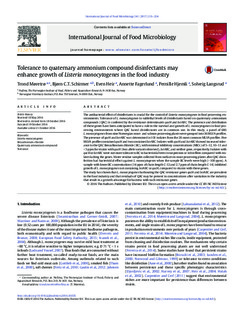| dc.contributor.author | Møretrø, Trond | |
| dc.contributor.author | Schirmer, Bjørn Christian | |
| dc.contributor.author | Heir, Even | |
| dc.contributor.author | Fagerlund, Annette | |
| dc.contributor.author | Hjemli, Pernille | |
| dc.contributor.author | Langsrud, Solveig | |
| dc.date.accessioned | 2016-11-02T12:46:22Z | |
| dc.date.accessioned | 2016-11-03T09:39:36Z | |
| dc.date.available | 2016-11-02T12:46:22Z | |
| dc.date.available | 2016-11-03T09:39:36Z | |
| dc.date.issued | 2016 | |
| dc.identifier.citation | International Journal of Food Microbiology 2016(241):215-224 | |
| dc.identifier.issn | 0168-1605 | |
| dc.identifier.uri | http://hdl.handle.net/11250/2419233 | |
| dc.description | - | |
| dc.description.abstract | The antibacterial effect of disinfectants is crucial for the control of Listeria monocytogenes in food processing environments. Tolerance of L. monocytogenes to sublethal levels of disinfectants based on quaternary ammonium compounds (QAC) is conferred by the resistance determinants qacH and bcrABC. The presence and distribution of these genes have been anticipated to have a role in the survival and growth of L. monocytogenes in food processing environments where QAC based disinfectants are in common use. In this study, a panel of 680 L. monocytogenes from nine Norwegian meat- and salmon processing plants were grouped into 36 MLVA profiles. The presence of qacH and bcrABC was determined in 101 isolates from the 26 most common MLVA profiles. Five MLVA profiles contained qacH and two contained bcrABC. Isolates with qacH and bcrABC showed increased tolerance to the QAC Benzalkonium chloride (BC), with minimal inhibitory concentrations (MICs) of 5–12, 10–13 and < 5 ppm for strains with qacH (two allele variants observed), bcrABC, and neither gene, respectively. Isolates with qacH or bcrABC were not more tolerant to BC in bactericidal tests in suspension or in biofilms compared with isolates lacking the genes. Water residue samples collected from surfaces in meat processing plants after QAC disinfection had bactericidal effect against L. monocytogenes when the sample BC levels were high (> 100 ppm). A sample with lower BC concentrations (14 ppm of chain length C-12 and 2.7 ppm of chain length C-14) inhibited growth of L. monocytogenes not containing bcrABC or qacH, compared to strains with these genes.
The study has shown that L. monocytogenes harbouring the QAC resistance genes qacH and bcrABC are prevalent in the food industry and that residuals of QAC may be present in concentrations after sanitation in the industry that result in a growth advantage for bacteria with such resistance genes. | |
| dc.language.iso | eng | |
| dc.title | Tolerance to quaternary ammonium compound disinfectants may enhance growth of Listeria monocytogenes in the food industry | |
| dc.type | Journal article | |
| dc.date.updated | 2016-11-02T12:46:22Z | |
| dc.identifier.doi | http://dx.doi.org/10.1016/j.ijfoodmicro.2016.10.025 | |
| dc.identifier.cristin | 1393162 | |
| dc.relation.project | Norges forskningsråd: 207765 | |
| dc.relation.project | Fiskeri- og havbruksnæringens forskningsfond: 900521 | |
| dc.relation.project | Nofima AS: 10015 | |
| dc.relation.project | Nofima AS: 4144 | |
